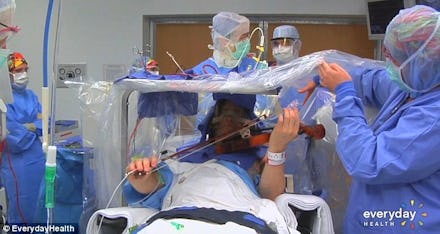This Man Is Playing Violin During His Own Brain Surgery

The news: A musician recently played the violin while — wait for it — having brain surgery.
By playing his violin during a brain operation, professional violinist Roger Frisch was able to guide his surgeons toward the segment of his brain where a misfiring signal was causing his hands to break out periodically in rhythmic shaking.
The surgery, called deep brain stimulation, involved doctors implanting a tiny electrode into Frisch's brain that blocks the tremor by delivering a zap of electricity to the part of the brain that was signaling in error.
Here's how they did it: After locating the part of Frisch's brain that was misfiring, a team of surgeons implanted two tiny electrodes deep inside. Using the electrodes, the doctors sent minuscule electric pulses into Frisch's brain. Next, they asked him to play his violin — the same movement that brought about his tremors.
Once the doctors were able to hone in on where the signals were being sent erroneously, they implanted the electrode permanently into the brain. Now, when Frisch feels a tremor coming on, he simply pushes a button linked by wire to the device (to turn it on) and the brain region is disabled, stopping the tremor.
Image Credit: Everyday Health
A potentially very useful technology: Frisch's treatment helped to reduce the symptoms of his tremor significantly. But he wasn't alone in his suffering — nearly 10 million Americans currently live with essential tremors, which can range from mild to severe shaking. In the severe cases, tremors can interfere with our most important activities, from drawing to sculpting or, in Frisch's case, playing the violin.
The technique doctors used to give Frisch back his career has exciting implications for other disorders as well. Deep brain stimulation (DBS) has been used in recent years to treat everything from Parkinson's disease to chronic pain, depression and obsessive-compulsive disorder. By normalizing the brain activity that goes awry in these conditions, DBS can drastically minimize symptoms. And because it leaves brain tissue unharmed (unlike more invasive procedures), DBS may also be reversible.
As a relatively new technology, DBS still needs some development, but by the time the procedure is ready for more widespread applications, chances are doctors will be able to apply the technique in as precise a manner as possible to ensure the most success.
h/t Everyday Health